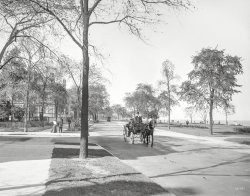
MAY CONTAIN NUTS

Search Shorpy
SHORPY ART

Framed or unframed, desk size to sofa size, printed by us in Arizona and Alabama since 2007. Explore now.
Join and Share
Ad-Free Shorpy
Shorpy is funded by you. Patreon contributors get an ad-free experience.
Learn more.

Recent comments
- Baldwin 62303
- Baldwin VO-1000
- Cold
- No expense spared
- Tough Guys
- Lost in Toyland
- And without gloves
- If I were a blindfolded time traveler
- Smoke Consumer Also Cooks
- Oh that stove!
- Possibly still there?
- What?!?
- $100 Reward
- Freeze Frame
- Texas Flyer wanted
- Just a Year Too Soon
- WWII -- Replacing men with women at the railroad crossing.
- Yes, Icing
- You kids drive me nuts!
- NOT An Easy Job
- I wonder
- Just add window boxes
- Icing Platform?
- Indiana Harbor Belt abides
- Freezing haze
- Corrections (for those who care)
- C&NW at Nelson
- Fallen Flags
- A dangerous job made worse
- Water Stop
Member Photos
The Shorpy
Print Emporium
Print Emporium
Search Shorpy
Search results -- 30 results per page
- Five Ways of Going: 1908
- ... up to their ears. They were called "pocket watches".
Omnibus? I believe the fifth mode is the Omnibus or autobus. I think there is one in the far distance, to the left. ... Posted by Dave - 06/03/2013 - 9:55am -
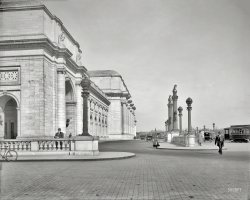
- Omnibus Stop: 1951
- ... to see and be seen.
Ablative The dictionaries say "omnibus" is the dative plural of "omnis" "all," implying it's "for all." I'd ... Posted by Dave - 03/09/2021 - 11:47am -
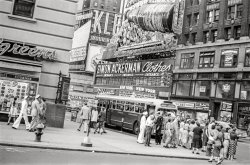
- Omnibus Stop: 1913
- July 10, 1913, New York. "Fifth Avenue Omnibus." View full size. 5x7 glass negative, George Grantham Bain ... Posted by Dave - 09/08/2011 - 1:00pm -
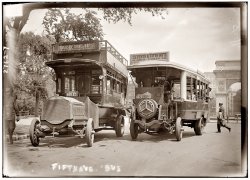
- Fifth Avenue Stage: 1900
- ... they have in many cities these days.
Also, the wagon/omnibus/ whatever, has no through braces so it must have been a bear to ride in.
Last days of the omnibus What a fantastic image! The street railway had largely replaced the ... Posted by Dave - 08/05/2018 - 4:02pm -
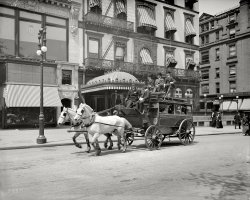
- Skyscraper: 1909
- ... no less than 20 streetcars. Is it 1912 rush hour?
Omnibus Ok, I'm the first to spot the motorized bus! It looks more like ... Posted by Dave - 07/28/2012 - 10:52pm -
![Skyscraper: 1909 New York circa 1909. "Panorama of Madison Square." This glass plate, part of a nine-exposure panorama, affords yet another view of that enduring architectural icon, the Flatiron Building. 8x10 dry-plate glass negative. View full size.
SprintLast time I was there in 2005, Sprint occupied the first floor of the Flatiron Building. Kind of sacrilege, really.
6 E. 23rdThe FDNY suffered its largest loss prior to 9/11 on the site of the Bartholdi Hotel. On October 17, 1966 a fire spread from an adjoining property on 22nd street to the basement of 6 East 23rd street. Twelve firefighters were lost that night when the floor of the Wonder Drug Store collapsed.
http://nyfd.com/history/23rd_street/23rd_street.html
Manure guyIn the foreground, white uniform, big shovel.
Awful AwningsBeautiful building, but the aesthetic is somewhat spoiled by the awning obsession of the era.
S.S. FlatironWith that puffy plume at the top, it looks like it's steaming up Broadway.
Deja Vu All Over AgainWe return to Madison Square Park (bottom left) and the back of the statue of William H. Seward, he of the folly. Also we see the Hotel Bartholdi, named after the Statue of Liberty sculptor. The corner storefront of the Flatiron Building appears to contain our old friend the United Cigar Store. On the next block, East 22nd Street, the corner is occupied by the VanGaasbeek Oriental whatever. That corner now houses a usually deserted Restoration Hardware, which appears to be in the original building that we see in the photo.
1 of 9Please don't leave us hanging; we want to see all 9 negatives!
As always, thanks for this.
And I wouldn't describe it as an awning obsession, more like a necessity on those hot New York August afternoons.
Ahhh summer!I am sure that the awning helped to keep the stores and offices cool in the summer. All the open windows (at least even one with a curtain blowing in the breeze) in skyscrapers! How odd to today's eyes of closed up buildings.
That sign selling cordial sure gave me a start.
Look at the TimeThe first thing that stuck out to me was the standing clock, which is very recognizable. It still stands there today. Also interesting is that that 200 Fifth Avenue, or International Toy Building (to the right of the Flatiron, next to the clock), was just built in 1912. It recently underwent an interior overhaul.
Awnings were a necessityThis was long before air conditioning was prevalent so awnings were a common method used to cool down a building while still maintaining the view out the window.
23 SkidooLegend has it that the unique winds created at this intersection (Fifth and Broadway at 23rd Street) would lift many a lady's skirt, much to the delight of the male audience that would congregate here (at least when women still wore dresses).
Awnings againThe main advantage of awnings (as opposed to, say, shades or venetian blinds) was that they let you keep the window open in the rain. Open windows were necessary probably as much for ventilation as keeping cool.
[Although they do seem more prevalent on the sunny side of the building. - Dave]
American ParthenonAlfred Stieglitz also saw the Flatiron as a kind of steamship: "With the trees of Madison Square covered with fresh snow, the Flat Iron impressed me as never before. It appeared to be moving toward me like the bow of a monster ocean steamer, a picture of new America still in the making. The Flat Iron is to the United States what the Parthenon was to Greece."
98 Years AgoIn the great span of history, 98 years isn't really all that long, and the march of history in centuries past wasn't all that brisk. But here we have a 1912 street scene from midtown Manhattan, less than a century ago (almost), within living memory of at least a few souls still among us, and the horses still outnumber the motor vehicles. I'm guessing that in another five years, by 1917 or so, the cars would outnumber the horses, and that in 10 more years -- 1927 or so -- the number of horses would be very small indeed. This is really a glimpse at the very last days of the pre-automobile world. We haven't lived with these infernal, gas-guzzling contraptions for very long.
M&L Hess Real EstateSign was still somewhat visible as of 2003.
http://www.14to42.net/20street1-2.html
From 1 to 9, slowly.If I look at the panorama too quickly, I may get dizzy.
Hotel BartholdiI am fascinated to find that this is the location of the Hotel Bartholdi. A few weeks ago I posted an image in the members gallery, of an electric charabanc parked, I assume, in front of the hotel.
The streets are full of peopleThat's something you don't see these days. People are afraid of speeding cars. I assume that horse-drawn carriages weren't quite as dangerous.
EntrancesComparing this picture with StreetView, the building entrances in the middle of each side seem to have been remodelled. Instead of the pillars supporting the canopy being proud of the main building, they are now just a relief on the surface.
White WingThe Department of Sanitation's "White Wing" sweepers did their level best keeping those NYC streets clean. I don't know if white was the best color for their uniforms though!
Google Clock ViewView Larger Map
The streets are full of streetcars, too!Including the blurry end of one on the extreme left, and off into the distance, I count no less than 20 streetcars. Is it 1912 rush hour?
OmnibusOk, I'm the first to spot the motorized bus! It looks more like someone chopped the back off a 1920s bus and shoved an open cab on the front with an engine. Neat! Also, notice the peculiar way of routing with a lampstand in the middle of the open street and ropes and posts in a line from it.
The clockWho maintained it?
I know there were lamplighters during the times when gas lamps lit city streets, but the clock must have been mechanical. Did someone wind it, or were they electric even back then?
Pach Brothers StudioIf you look close at the building behind the Flatiron you can see a billboard (on the roof) for Pach Brothers Studio. I took portrait classes from the last owner of Pach Brothers, Oscar White. When he closed the studio it was the oldest operating studio in North America. He had an amazing archive of famous clients' images. President Ulysses S. Grant was involved in getting the studio started.
Re: S.S. Flatiron and American ParthenonSomething as glorious as this had to appear sooner or later.
(The Gallery, DPC, Flatiron Building, NYC, Streetcars)](https://www.shorpy.com/files/images/4a10547a1-flatiron.thumbnail.jpg)
- Seeing New York: 1904
- ...
OK, so I want to know: Who killed the electric omnibus?
Tourist Destination At what point did NYC become a tourist ... ascend and descend the bus?
How far could an electric omnibus go before needing a recharge?
Duck Tours These remind me of ... Posted by Dave - 07/24/2012 - 9:51pm -
![Seeing New York: 1904 Circa 1904. "Seeing New York." Electric omnibuses at the Flatiron Building. 8x10 inch dry plate glass negative, Detroit Publishing Company. View full size.
In living colorColorized version of a very overloaded one used by the Fifth Avenue Coach Company:
PricelessThis is one of my favorite Shorpy pics ever. The expressions on all the faces speak volumes. Great.
I believe it's called a charabancThere's a picture of another electric charabanc at https://www.shorpy.com/node/7251 . The name is a good description: charabanc = char-à-banc = bench carriage. According to Wikipedia, mostly used for sightseeing and daytrips, safety record not great.
How very usefulA Telephone Connection is mentioned on the omnibuses - but not the number.
OMGWhat about the ghost lady in the back?
The choice of the futureIt was a time when there was not yet a clear choice on which energy would propel the cars and trucks. You had electric engines, gasoline engines and even steam engines in almost equal numbers on the streets.
Hard work.It must have been a real handful to navigate that beast through the streets of Manhattan.
TouristsI can't get over how well dressed this visiting group is. If you wander over to Times Square, or even the Flatiron these days you see a lot of people in shorts and T-shirts, many overweight and continuously munching. The more formally dressed 1904 crowd may have been a bit much, but somewhere in between there is an answer.
The Case of the Toppled TouristsWow, no sidewalls, safety belts or anything. I don't imagine those bus boats were in service for very long.
Electric?From what's visible of the undercarriage, it looks like these are driven by electric motors.
[Hmmm. Maybe that's why they are described in the caption as "electric omnibuses"! - Dave]
Guess I really ought ro read 'em once in a while, eh?
A warning for the ladiesDon't visit the Heel Building!
QuackThese sightseeing contraptions are as ugly and ungainly as the "duck" amphibious sightseeing vehicles which are seen in many cities, these days. Ottawa has a number of these monstrosities blocking traffic during tourist season.
Nothing beats making tourists stick out like sore thumbs.
Fred MacMurray You can't hide behind that mustache. Smart to have your hat attached by that wind trolley too.
People were just so civilized back then. Being clean and proper was the order of the day. Lady in Row 5 seems to be making sure her companion is up to snuff.
OK, so I want to know:Who killed the electric omnibus?
Tourist DestinationAt what point did NYC become a tourist destination, where people come just to see the city itself, as these people are doing?
I guess that sort of thing doesn't just happen at a "point in time," but gradually.
Timely questionsI surmise that the doors on the sides of the cars open up to allow for artfully placed hidden steps for boarding? How else would a lady's delicate and well turned heel ascend and descend the bus?
How far could an electric omnibus go before needing a recharge?
Duck ToursThese remind me of the Duck Tour vehicles in Boston and other cities. Refurbished WWII amphibious vehicles. It's also neat to see the guy in the last row with his hat clip attached so he won't lose it in the wind.
Vehicle Equipment CompanyThese “Automobile buses” were made by the Vehicle Equipment Company of Long Island City, New York. Their literature called them “A combination of the commercial and pleasure types.”
The Vehicle Equipment Company was started in Brooklyn in 1901 by Robert Lloyd and Lucius T. Gibbs. By 1903 they had relocated to Long Island City. Up until mid-1906 they built a large number of commercial electric vehicles. From 1903 to 1905 they also built a 3-seat electric car called the VE Electric. Almost all of their vehicles were single motor shaft-drive. The company went into receivership in 1906, and the General Vehicle Company (owned by the General Electric Company) purchased the factory and reorganized to build both gasoline and electric vehicles, as well as replacement parts. Vehicles built from mid-1906 on were known as GV Electrics.
By 1915 there were some 2,000 GV Electrics in New York City alone, representing more than 25% of all trucks of all types working daily in the city. The style of “Automobile bus” seen above was also very popular in Washington D.C. and other cities as well.
General Vehicle Company ceased production around 1917.
AdvertisementFrom the Daily News Tribune of June 26, 1904. This ad occurs only in June and July issues. Most likely, they did't work so long.
(The Gallery, Cars, Trucks, Buses, DPC, Flatiron Building, NYC)](https://www.shorpy.com/files/images/4a11803a.thumbnail.jpg)
- Made in America: 1937
- ... modern English -- it's as antiquated as "aeroplane" or "omnibus." Back in the age of airships when it was in currency, the word was, ... Posted by Dave - 08/26/2012 - 11:43am -
![Made in America: 1937 June 9, 1937. "Congress sees model of new proposed American-designed dirigible. Rep. Edward A. Kenney (right) of New Jersey, Chairman of the House Interstate Commerce Committee, viewing a model of a new American designed dirigible displayed at the Capitol today. Roland B. Respess, President of the Respess Aeronautical Engineering Corp., is pointing out the features of the ship to the House member. The House Interstate Subcommittee is hearing the witness on a bill recently introduced to authorize the loan of $12 million for constructing two eight-million-cubic-foot dirigible airships, a large American airship plane, and Atlantic operating terminal with a view toward establishing twice-a-week Trans-Atlantic airship service." Harris & Ewing glass negative. View full size.
Full of ItWere they going to use all the "hot air" from Congress to fill it up?
DirigiblesI can't say they were a total flop. The Goodyear Tire & Rubber Company seems to be happy with theirs.
Opportunity KnocksThis was a month after the Hindenburg blew up.
Not a blimpDirigibles are different than blimps. Goodyear and most of those balloons you see flying over stadiums are blimps, not dirigibles.
[Not so. Dirigibles (steerable airships) include blimps. - Dave]
Not Quite, DaveOriginally, "dirigible" DID mean "steerable," irrespective of the nature of the airframe. But, over time, its usage changed to mean an airship with a rigid internal skeleton (as in a Zeppelin), as opposed to an airship with no internal framework (Blimp). Both types of craft were indeed steerable, but the usage lost that distinction.
[It may be common usage, but "dirigible" does not mean "rigid airship." It's a mistaken notion resulting from confusion over the similarity of the words "rigid" and "dirigible." Which still means "steerable." The only term properly used to refer to rigid airships is "rigid airship." - Dave]
Several hundred man-hours of work,...and they stand it on the back of a few chairs? Hmmm, built with tax dollars, no doubt.
The real questionis whether Rep. Edward A. Kenney of New Jersey, Chairman of the House Interstate Commerce Committee, really wanted history to remember him for wearing white shoes.
He's A-Ok...Mr. Kenny's choice of footwear is protected because he is wearing them between Decoration Day and Labor Day. The unofficial White Shoe Season.
Have a seat.I can see why Rep. Kenney was made chairman of the committee.
Innovative DesignThe patent application for Respess's airship indicates that he was proposing a design to prevent the type of structural failure that had caused the crashes of several earlier US airships (USS Akron, Macon, Shenandoah). He had a number of interesting ideas about control systems and other features that would have brought airships up to late-1930s standards. But the Hindenburg was the nail in the coffin of any possible development of this thinking. His trip to DC with this model was probably a last-ditch effort.
AmazingAmazing that this was still pursued regardless of the Hindenburg. All but one of the Navy's post-WWI airships were lost in foul weather, including the USS Shenandoah. I've got a small piece of its fabric in my desk right now. USS Akron, Shenandoah, and Macon all went down, and only the USS Los Angeles survived to see dismantlement in '39.
Excellent DetailBeneath it are detailed scale models of the chairs that will be used to support it once it takes flight.
Sometimes a dirigibleis just a dirigible.
The value of ShorpyFor getting us (including myself) right on the definition of dirigible. My day isn't complete without my Shorpy. Thanks Dave.
New form of suspensionThey've discovered a new way to keep dirigibles in the air -- bentwood chairs!
No SmokingDo you suppose the No Smoking sign in the back is a safety measure intended to protect the honorable members of the committee in the event of hydrogen leaks?
EtymologyEtymology is not destiny; that "dirigible" means "steerable" (or "directable" maybe?) rather than "rigid" does not change the fact that a blimp is NOT properly called "a dirigible" in modern English.
["Dirigible" is hardly modern English -- it's as antiquated as "aeroplane" or "omnibus." Back in the age of airships when it was in currency, the word was, for the most part, properly used. It's the airship fanbois of the modern era who got things mixed up. - Dave]
Yeah, baby . . ."Fanbois"
THAT'S what I'm talkin' about.
Foy
Las Vegas
(The Gallery, D.C., Harris + Ewing, Zeppelins & Blimps)](https://www.shorpy.com/files/images/22846a.thumbnail.jpg)
- Dearborn Street Station: 1910
- ...
Depot Hack The Parmelee vehicle is a depot hack or omnibus, not a trolley car.
My beholding eyes I dunno, it looks like it ... Posted by Dave - 07/20/2012 - 3:44pm -
![Dearborn Street Station: 1910 Chicago circa 1910. "Dearborn Street Station." Streetcar wires and a small ghost pedestrian not entirely banished by the retoucher's hand. View full size.
Those RoofsThose sloped roofs got me busted cheating in architecture school. During my first year we had a sketch class and one of our assignments was to sketch this station. It was a particularly cold December morning so I bought a postcard of the station at a bookstore and sketched it from that. Unfortunately the postcard showed the station with the pre-fire sloped roofs, a distinction my professor was all too quick to point out.
Top lopI'm sorry they lopped off the top of the tower. It was weird looking but interesting. It looked like there must have been little rooms up there. I wonder what was in them.
Boxes with handles?Does anyone know what the boxes with handles located next to the curbs were for?
[They're for getting into a carriage. Called mounting blocks when they're made of stone. - Dave]
Somebody step upAnd identify that automobile.
Make that one to beam up, Mr. ScottThat is just about the most hamfisted "retouching" work I have ever seen. It looks like someone from Starfleet is either transporting back to the Enterprise, or is about to materialize in Taft era Illinois.
[Our image comes directly from the negative. Once it was printed, the results were probably more convincing. - Dave]
Dearborn Station todayThanks for this great picture. This wonderful building is still standing and has been made into shops in the center of the Printer's Row area of Chicago. We were there this summer for the Printer's Row Book Fair.
[They lopped off the top! And painted it orange! - Dave]
How many [fill in here] does it take to change?That's one helluva a light bulb on that street pole.
[What looks like a bulb is the glass globe covering the electrodes of a carbon arc lamp. - Dave]
Parmelee SystemThe trolley was part of the conglomerate founded by Frank Parmelee in 1853. The company held franchises in many cities. I remember taxicabs in NYC in the 1940s & 50s that bore the legend "Parmelee System." In the 1930s his company was absorbed into the Checker Cab company and was around into the 1980s. Another interesting acquisition was the Yellow Cab Co., created by John Hertz, he of car rental fame.
We'll discuss the Gold Dust Twins another time.
Before the operationThat's an extraordinary tower. What a shame that it's since been - I'm afraid no other word will do - circumcised.
You have to be kidding!They might have lopped the top off the building because they couldn't find a roofer to bid on retiling that wonderful but scary steep structure.
The Station Got ScalpedThe "cuckoo clock" roof of the tower, and all the other pitched roofs on the building, were removed after a 1922 fire. The train shed in the back was demolished in 1976. Fortunately the rest of the station is intact. I remember going there with my father in 1969, when the station was still in operation, to see the the Flying Scotsman, the famous British steam locomotive. It was making a nationwide tour that year on this side of the pond. I got to blow the whistle!
My company visits this building daily. I've loved this place since we've been visiting on a daily basis. Great pic, as always!
Depot HackThe Parmelee vehicle is a depot hack or omnibus, not a trolley car.
My beholding eyesI dunno, it looks like it got blotto at a party and stuck a lampshade on its head.
TransposedThose steep roofs, especially the lamented steeple roof, look like the roofs you might see in Geneva or Bern, Switzerland. It is a shame they lopped off the steeple roof. Probably a cost or structural issue.
[It was a fire issue. See below. - Dave]
Adam's RibsWhere is the rib joint? Hawkeye ordered ribs from Adam's Ribs from Korea. It was across the street from the Dearborn Street Station. He forgot the coleslaw, though...
He sidles up to the podium, clears his throat--I'll guess it's a 1910 Hudson, based on the firewall and windshield shapes, 3/4-elliptic springs, contracting brakes, radiator shape and steering-wheel controls. I know there were oodles of other makes that probably shared some of these features, so I'm prepared and eager to be corrected!
A clean exteriorHard to imagine such an important public building owned by private companies not adorned with the name of the structure and who the tenants are. This was the very important East end of the Santa Fe as well as the Chicago terminal for the Chicago & Eastern Illinois, Monon, Erie, Grand Trunk and others over the years.
We lost one ofthe "Gold Dust Twins" on that sign at the right of the frame.
Adam's Ribs, anyone?I am surprised that no one mentioned the episode of M*A*S*H in which the Dearborn Street Station featured.
Tired of having eaten a "river or liver and an ocean fish,"* Hawkeye had a hankering for BBQ from Adam's Ribs, which was "across the street" from the station.
* "I've eaten a river of liver and an ocean of fish! I've eaten so much fish, I'm ready to grow gills! I've eaten so much liver, I can only make love if I'm smothered in bacon and onions!"
AddressWhat is the physical address of this place? I visit Chicago often and would like to go there in person.
[Click here. - Dave]
Thar She GoesThe fateful day the roofs were lost. Sad.
He sidles up to the podium, clears his throat--Well done, Watchwayne! I agree with you it must be a Hudson. At first I thought Overland then perhaps Mercer and even Buick because all have similar radiator shapes, but none of them have those distinctive rear springs, but I knew that I had seen them before. Congratulations!
Hello, DaveJust to tell you how much I enjoy old photos like this of Dearborn Station. I am deeply appreciative of your time and talent. I especially like the scarcasm, as long as it's not directed at me.
[Scarcasm -- so hurtful. Disfiguring, even. - Dave]
That Beautiful Car Seems to be a 1911 Warren-Detroit.
http://forums.aaca.org/f170/mystery-car-291988.html
+107Below is the same view from June of 2017.
(The Gallery, Chicago, DPC, Railroads)](https://www.shorpy.com/files/images/4a24000a.thumbnail.jpg)
- Buffalo Bank: 1908
- ... The last charabanc we saw was here . A kind of open-air omnibus.
Death by Buffalo Mark Twain once said, "To commit suicide in ... Posted by Dave - 07/22/2012 - 10:39am -
![Buffalo Bank: 1908 Bustling Buffalo, New York, circa 1908. "Erie County Savings Bank, Niagara Street." Another view of the imposing edifice previously seen here. 8x10 inch dry plate glass negative, Detroit Publishing Company. View full size.
I don't know, but --I think buildings can be both hideous and delightful, at the same time.
Harry Potter's other school?I swear this looks like it should be a school of magic! What a GREAT building!
The entire scene is cool. I love all of the business names painted on the windows and the detailing. The spires are simply amazing.
Fare to Niagara and backFifty cents roundtrip! Last time I went to Niagara from Buffalo my niggardly tip was $20. I forget the fare. Inflation has come a long, long way.
What were the Yellow Cars?
With a name like Hazard . . . This time, Frank Williams has an officemate -- Willet E. Hazard. Corporate attorney Hazard and his brothers would incorporate a gasoline motor manufacturing company in 1909. First named Hazard Engineering Co., it would soon become Hazard Motor Manufacturing Co. The slogan in a 1912 ad in "The Rudder," a yachting magazine, claims "The 'HAZARD' is distinctly better." That is the last mention of the company to be found. Wonder why?
Awesome!That's a great shot! I love the whole scene. The building is intense, why don't they make them like that anymore?
What in the worldAre those little square things under the Swift's billboard?
[An electric sign. Just wait till dark! - Dave]
Looks like rainI count at least five gents carrying umbrellas.
Erie Bank - This Is Your Lifehttp://www.buffaloah.com/h/eriebank/index.html
I'm just one guyBut that hideous thing looks like a Kremlin prison to me.
A Shorpy stapleThe last charabanc we saw was here. A kind of open-air omnibus.
Death by BuffaloMark Twain once said, "To commit suicide in Buffalo is redundant."
Or words to that effect. But it looks full of life to me! Love the long street view, and all the wonderful signage.
The obelisk next doorAnyone know what the white monument is for down the street?
Seven LampsWhen the term "architecture" is used, this is the type of structure they are referring too. Anything else is just another building.
"To commit suicide in Buffalo is redundant"That was a quip by Neil Simon, used in "A Chorus Line."
OmnibusesJust checked out the previous photo of the same bank. There are two omnibuses in front, one like that seen in this pic (probably electric; right-hand drive, too) and the other, just nosing into the lower left corner, is definitely gasoline-powered if that hood is any indicator. So I guess these things were pretty common.
Imagine Winter!This same scene would be filled with Horse Drawn Sleighs...what a fun way to get around!
No WordsI don't know what to say other than that is one of the most beautiful buildings I have seen on Shorpy. The thought of the wrecking ball plowing through those gorgeous granite walls makes me want to cry like a baby.
Charabancs!Here's why I love this site. I never heard of a "charabanc" until Shorpy. I just thought they were funny little buses. You can read all about it at http://en.wikipedia.org/wiki/Charabanc
The obeliskis the McKinley Monument in Niagara Square.
Pay your dimeand climb up to the top of the tower and choke to death on the emissions of that nearby smokestack. A testimony to the air quality of the time is that the upper floors of all the buildings are blackened with soot.
It's an electric signProbably a static illuminated letter board, vs. the Times Square style "crawl" which I think was beyond the technology of the day (though not TOO far beyond).
The bulbs aren't really bright enough to work well in daylight.
The message may have changed nightly, each letter was controlled by a large rotary wafer switch housed in a wooden box, that when turned would cause the bulbs in the sign to display a different letter at each position.
High technology, 1908 style.
Shorpy, keep these images coming, I love poring over them. America near its peak as the industrial power of the world, with no end in sight. The age of coal, steam and steel.
Weird coatThere's a man on the right side of the street, to the left of the cigar store awning, his back to the camera. What are all those white things hanging off the back of his coat? And is he holding a banjo in his right hand?
[Those are scratches and blotches in the emulsion. - Dave]
Nothing remainsEssentially everything in this image except the McKinley Monument was destroyed in "urban renewal" in the 1960s. The site of the bank now appears to be a boring late-Sixties state office building. I can't find any trace of any other original building in this image.
There was a good story written in 1967 when the Erie County Savings Bank was demolished.
(The Gallery, Buffalo NY, DPC, Streetcars)](https://www.shorpy.com/files/images/4a22504a.thumbnail.jpg)
- White Line: 1924
- ... hat Is that a smashed hat in the foreground? Very nice omnibus.
Location I think it's right in front of the Atkinson Garage ... appear that there was a great deal of ventilation for this omnibus. In a time before antiperspirants and in wool clothing, no ventilation ... Posted by Dave - 09/13/2011 - 12:10pm -
![White Line: 1924 Washington, D.C., circa 1924. "Continental White Line bus." Who can pinpoint the location here? National Photo Co. Collection glass negative. View full size.
That hatIs that a smashed hat in the foreground? Very nice omnibus.
LocationI think it's right in front of the Atkinson Garage Company.
Air!It doesn't appear that there was a great deal of ventilation for this omnibus. In a time before antiperspirants and in wool clothing, no ventilation would be a bad thing. I can just imagine some of the tours were rather ripe.
It could smell like the Lancaster County Farmer's Market on a rainy Friday in July after the Amish have been picking corn all week. The kind of smell that's nearly visible.
[The four-section windshield is hinged and opens for ventilation. Deodorants, which go back to the 19th century, were well established by the 1920s. - Dave]
Atkinson GarageAccording to an ad in the Washington Post (May 7, 1922), Atkinson Garage was in "Blagdon's Court" between 9th and 10th, M and N Streets NW.
[That didn't take long! Now called Blagden Alley. - Dave]
1244 Blagden Alley NWView Larger Map
Little has changedBetween the photo and the Google pic. Can even see where the drain cover in the foreground was -- the dark circle on the left in the Street View.
[Wouldn't it be funny if that hat was still there. - Dave]
"Auto Repair Inc."Another view of the old garage in Blagden Alley. Note the ghost lettering on the beam across the garage door. Google Maps goofed on the street name's spelling!
PsssssstI don't think I'd have a lot of faith in that right front tire. It looks like a bad "re-capping" job is about to delaminate - blowout!
You Da' Man, Cranch!This is the sort of thing that makes Shorpy the best website ever.
Re: That HatBy day: dutiful civic transport. By night: wanton destroyer of ladies' millinery.
Gorgeous!I'm not usually very interested in vehicles of that age but that's got to be one of the most beautiful bus bodies I've ever seen. The designer was obviously someone who saw coachbuilding as an art rather than a job; just look at the sweep of the roof line - there's not a straight section in it.
I'm so lucky!How lucky am I? My software business is located directly across the alley from this building. Blagden Alley rocks; we love being there amongst the history, trying to build something new.
The New Blagden AlleyAtkinson Garage is soon to be open as R.J. Powers' restaurant Rogue24. The back doors of Wagtime and Long View Gallery are straight ahead. It's gratifying to see what is happening in DC these days, and wondrous and to see what was happening in DC those days. With a few decades of disrepair in between.
Truck MarqueWhat is the name on the radiator/grille below the fluting on top of the radiator? It appears that the manufacturer's name might be written diagonally below.
Also, note the interesting mechanical device attached to the door. When the door opens up, the step automatically goes down.
(The Gallery, Cars, Trucks, Buses, D.C., Natl Photo)](https://www.shorpy.com/files/images/30360u.thumbnail.jpg)
- Park Hotel: 1905
- ... Marie, but "transfer" lines almost always referred to omnibus services that ran between the railroad depot and local hotels. The far ... Posted by Dave - 08/20/2012 - 4:21pm -
![Park Hotel: 1905 Sault Sainte Marie, Michigan, circa 1905. "Park Hotel." An interesting cast of characters in less than parklike surroundings. Detroit Publishing. View full size.
VacancyThe Soo still has a lot of old buildings, but this one was torn down in 1972. In the early 1900s, most people came to the Soo via ship and occasionally rail, and most if not all hotels were down by the river. Today there are only a few still hanging on for the tourists, and most motels are franchises up on the business spur near the highway and fast food.
Grain Belt export?Seems a long way from home in Minneapolis for 1905.
[Minneapolis Brewing Company operated a regional network of brewhouses, bottling plants and storage depots. By the turn of the century, Grain Belt could be had from Michigan to Montana. - Dave]
That hot, stuffy gable roomIf it's not a "box room" (the name is self-explanatory), it might well be a room for servants, cooks, and/or staff. The rooms closest to the roof are always the least desirable, and thus relegated (even today) to the help. After all, the workers aren't supposed to be in their rooms very much anyway!
What I'm wondering about is the collection of courtly, retired, mustachioed gentlemen on the porch. In the winter, would they gather in a public parlor with a coal stove? They all look as if they could easily reminisce about the cold and muddy bivouacs they endured "tenting tonight on the old camp grounds" during the Civil War.
Gable RoomThese old buildings (of course it wasn't old then) always have what I call "fun" or "mysterious" rooms jutting up out of them that make me wish I knew what they were like inside. In this one it's is the gable room -- that's where I would want to stay if in fact it's a used room and not just a decorative add-on. There can't be much of an attic because the rest of the roof is flat.
Transfer? From what? To where?Now here's a picture full of questions. I see two very proper ladies in waiting standing next to one or two gentlemen who "moved." One shoe shine man. Three newsies and one non-newsie. Five gents on the porch. Three drivers and four and a half horses. What I'd like to know is what kind of "transfer" is indicated by the sign over the ladies and the printing on the sides of the coaches. I see rails in the street but no overhead wires. Maybe for horse drawn rail cars? (There is definitely horse evidence between the rails.) Or maybe it's a steam railroad? Have the ladies been brought to this point by one of the transfer coaches and now await a train? Looks like there are short stairs midway down the hotel's hallways where the building addition starts, as the windows don't match up. Add a "grain belt" sign, a mailbox, a fireplug, a decrepit bill on the "telly-pole," the electrified transfer sign, and you have a fascinating scenario. The only thing we don't see is the photographer. Who was he and why was he taking the picture?
[There is a big thick streetcar wire overhead. The sign says FREE EAGLE LIVERY TRANSFER (scroll up). The photo is one of many thousands made by Detroit Publishing Company for use as postcards and prints. - Dave]
Here It IsI like the sign across the middle of the street that helps you locate the Park Hotel. From the position of the sign, I'd presume that the majority of folks are heading there from the left side of the picture. Interesting.
Soo Memories, NOTFunny - I lived in the Soo from '67 to '70 and drank in a hole-in-the-wall bar right next to where Google says the Park Hotel was, but I have no recollection of it. Maybe I should have drunk less.
Then again, the Soo was pretty down at the heels back then and the hotel may have been just another derelict building.
The Eagle Suffers Little Birds to SingThe sign says EAGLE LIVERY TRANSFER. The wagons belong to the Eagle Transfer Company, who held a concession with Duluth, South Shore and Atlantic Railway.
It might not look parklike to us, but the camera was on the edge of a nicely landscaped park overlooking the locks. Plenty of shots exist on Library of Congress site.
Acme Inc.That phone pole looks like one of Wile E. Coyote's props, cocked to flatten the Road Runner. Of course that's not how things will turn out.
The hotelIt's down at the end of Lonely Street, or was that the Heartbreak?
Much in need of a First Class shoe shineEspecially with all the mud, etc., on that street. I shudder to think how shoes shined in a Second Class Manner would turn out!
Ghosts of years pastI like the ghostly shoe by the shoe shine sign, very apropos and there are two apparations beside the ladies. I think this should give us pause to slow down in life and watch for photographers so that we don't end up as a blur in the background in the future.
Back in '71I was stationed at nearby Kincheloe A.F.B. My buddies and I spent many an evening "painting the town", mosquitoes and snow permitting. I'd sure like to know exactly where this building was so I could search my memories. If it was near the locks and was indeed still standing in 1971 I might remember having seen it.
[The Park Hotel was at the southeast corner of Douglass Street (later Osborn Boulevard) and West Portage Avenue, according to this book. - Dave]
Transfer LineI'm not familiar with the situation in Sault Sainte Marie, but "transfer" lines almost always referred to omnibus services that ran between the railroad depot and local hotels. The far was usually 25 cents round trip, and typically a traveler was given a token or ticket to use for the return trip back to the railroad depot after his business was done in town.
(The Gallery, DPC)](https://www.shorpy.com/files/images/4a22789a.thumbnail.jpg)
- Rubberneck Auto: 1911
- ... and Walker of Philadelphia to a modified London General Omnibus Company design. One of the series was previously posted on Shorpy . ... Posted by Dave - 08/01/2012 - 5:48pm -
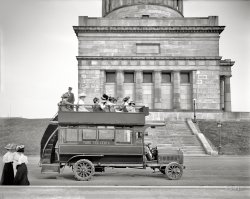
- Chicago Fog: 1942
- ... and the Fifth Avenue Coach Company were both owned by the Omnibus Corporation and shared the same paint scheme. And the Omnibus Corporation and the Yellow Truck and Coach Manufacturing Company were ... Posted by Dave - 02/13/2017 - 1:03pm -
![Chicago Fog: 1942 December 1942. "Chicago, Illinois. An unusually heavy fog in the early afternoon." Photo by Jack Delano for the Office of War Information. View full size.
After That Bus, Watson!Save for the street furniture and bus markings, this could be London on a clear day back when everyone heated with coal. The buses' position on the street gives nothing away because they appear to be driving roughly in the middle -- a tendency toward which has not infrequently been ascribed to bus drivers on both sides of the water.
Royalty in the MistThe double-decker bus looming out of the fog is a Yellow Coach Model 720, which was nicknamed Queen Mary in a nod to the famous Cunard superliner RMS Queen Mary, launched in 1936.
The Chicago Motor Coach Company had 100 of the Series 2 that were built in 1936, and 40 of the Series 4 (fuel tank and battery location moved to eliminate fire hazards) that were built in 1938. They proved to be very useful and many of them were rebuilt several times before finally being retired in the early 1950s. The Fifth Avenue Coach Company bought 25 Series 3 and 35 Series 5, which were the New York versions of the Series 2 and Series 4 respectively, with some body changes.
According to New York Fifth Avenue Coach Company: 1885-1960 by Oliver J. Ogden, bus Number 104 (seen in the bright sunlight below) was:
the Yellow Coach demonstrator for the new Queen Mary Design. After it was shown in New York, it kept the No. 104 but was relettered "Chicago Motor Coach." It stayed with Chicago and then was sold to Coast City Coaches of New Jersey in 1945. [Via Motor Bus Society]
Actually, it was destined for Chicago all along as it was intended to replace No. 103—the 1933 Model 706 prototype that was the basis for the Model 720 (and which, after retirement, appeared in several movies). The New York Model 720s were numbered in the 2000s. No. 104 was actually the only Series 1, built in 1934 and used in 1935 as a demonstrator on Route 5 in New York City before being sent to Chicago to be put into regular service.
Why all the swapping around? Because both the Chicago Motor Coach Company and the Fifth Avenue Coach Company were both owned by the Omnibus Corporation and shared the same paint scheme. And the Omnibus Corporation and the Yellow Truck and Coach Manufacturing Company were the brianchilds of John D. Hertz, along with Hertz automobiles, Hertz Rent-a-Car, Yellow Cab Company, etc., etc.
The Model 720 were visually similar to the Yellow Coach Model 735s, but Chicago Motor Coach Company did not acquire any Model 735s. A 1936 Series 2 is seen below.
They were so popular that kids got to get in on the action.
(The Gallery, Cars, Trucks, Buses, Chicago, Jack Delano)](https://www.shorpy.com/files/images/SHORPY-8d23808a2.thumbnail.jpg)
- Radio Highlights: 1957
- ... command post of the Strategic Air Command.”
WRC “Omnibus: Composer Conductor Leonard Bernstein with highlights from the stage ... Posted by Dave - 06/02/2017 - 12:50pm -
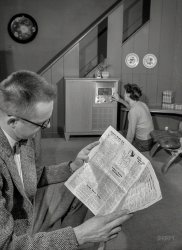
- Modern Family: 1900
- ... Virginia looked on as she was left behind for the family omnibus outing.
I LIKE MY CAR That's what I think every time I see a ... Posted by Dave - 08/05/2012 - 3:14pm -
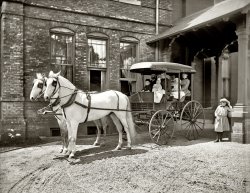
- Park Avenue Hotel: 1905
- ... At least one of the fancy carriages appears to be an omnibus, a public conveyance, and may have a regular run from the hotel to a ... Posted by Dave - 04/17/2014 - 10:19am -
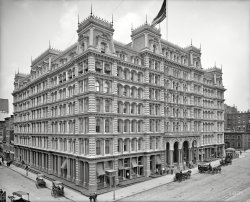
- Out and About: 1905
- ... A nice day for a carriage ride, and look out for that omnibus. 8x10 inch dry plate glass negative. View full size.
Out and ... Posted by Dave - 07/22/2014 - 10:03am -
